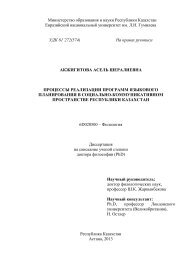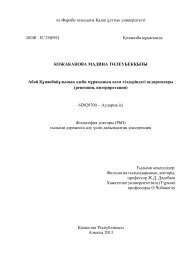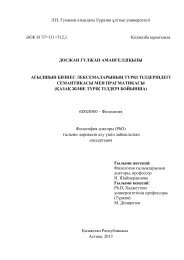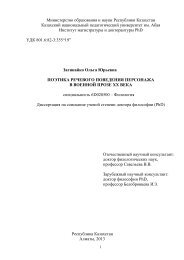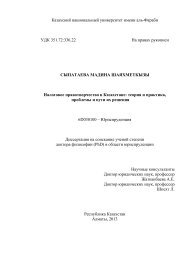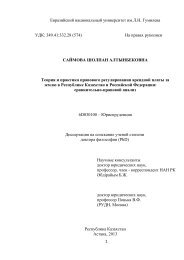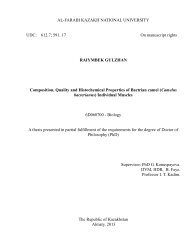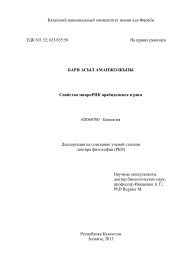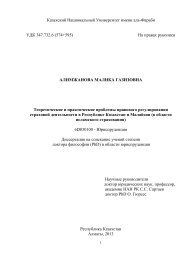dissertacia-myrzabaeva.pdf
Create successful ePaper yourself
Turn your PDF publications into a flip-book with our unique Google optimized e-Paper software.
1989. - №240. – P. 1302-1309.<br />
101 Gossett D.R., Millhollon E.P., Lucas M.C. Antioxidant response to NaCl<br />
stress in salt-tolerant and salt-sensitive cultivars of cotton. // Crop Sci. 1994. -<br />
№34. – P. 706–714.<br />
102 Hernández J.A., Olmos E., Corpas F.J., Sevilla F del Río L.A. Salt-induced<br />
oxidative stress in chloroplast of pea plants. // Plant Sci. 1995. - №105. –<br />
P.151–167.<br />
103 Hernández J.A., Jiménez A., Mullineaux P.M., Sevilla F. Tolerance of pea<br />
(Pisum sativum L.) to long-term salt stress is associated with induction of<br />
antioxidant defenses. // Plant Cell Environ.2000. - №23. – P.853–862.<br />
104 Mittova V., Volokita M., Guy M., Tal M. Activities of SOD and the<br />
ascorbate-glutathione cycle enzymes in subcellular compartments in leaves<br />
and roots of the cultivated tomato and its wild salt tolerant relative<br />
Lycopersicon pennellii. // Physiol. Plant. 2000. - №110. – P. 42–51.<br />
105 Mittova V., Tal M., Volokita M., Guy M. Up-regulation of the leaf<br />
mitochondrial and peroxisomal antioxidative systems in response to saltinduced<br />
oxidative stress in the wild salt-tolerant tomato species Lycopersicon<br />
pennellii. // Plant, Cell Envir. 2003. - №26. – P. 845-856.<br />
106 Ben Amor N., Ben Hamed K., Debez A., Grignon C., Abdelly C.<br />
Physiological and antioxidant responses of the perennial halophyte Crithmum<br />
maritimum to salinity. //Plant Sci. 2005. - №168. - Р. 889 - 899.<br />
107 Cramer G., Alberico G., Shmidt C. Salt tolerance is not associated with the<br />
sodium accumulation of two maize hybrids. // Austr J.Plant physiol. 1994. -<br />
№ 21. – Р. 675-692.<br />
108 Noctor G., Foyer C.H. Ascorbate and glutathione: Keeping active oxygen<br />
under control. // Ann. Rev. Plant Physiol. Plant Mol. Biol. 1998. - №49. – Р.<br />
249-279.<br />
109 Smirnoff N. The function and metabolism of ascorbic acid in plants. // Ann.<br />
Bot. 1996. - №78. – Р. 661-669.<br />
110 Ines Urquiaga., Federico Leighton. Plant polyphenol antioxidant and<br />
oxidative stress. // Biol. Res. 2000. - №33. – P. 55-64.<br />
111 Abdi S., Ali A. Role of ROS modified human DNA in the pathogenesis and<br />
etiology of cancer. // Cancer Lett. 1999. - №142. – P. 1-9.<br />
112 Chanwitheesuk A., Teerawutgulrag A., Rakariyatham N. Screening of<br />
antioxidant activity and antioxidant compounds of some edible plants of<br />
Thailand. // Food Chem. 2005. - №92(3). – P. 491–497.<br />
113 Maisuthisakul, P., Pongsawatmanit, R., Gordon, M.H. Antioxidant properties<br />
of Teaw (Cratoxylum formosum Dyer) extract in soybean oil and emulsions.<br />
// Journal of Agricultural and Food Chemistry. 2006. - №54. – P. 2719–2725.<br />
114 Dixon R.A., Paiva N.L. Stress induced phenylpropanoid metabolism. // Plant<br />
Cell. 1995. - №7. – P. 1085-1097.<br />
115 Ksouri R., Megdiche W., Debez A., Falleh H., Grignon C., Abdelly C.<br />
Salinity effects on polyphenol content and antioxidant activities in leaves of<br />
the halophyte Cakile maritime. // Plant Physiology and Biochemistry. 2007. -<br />
95




